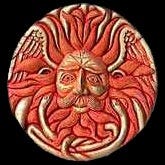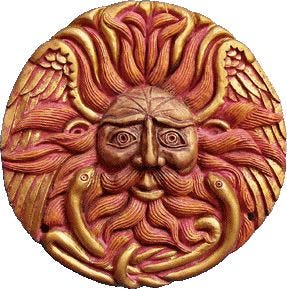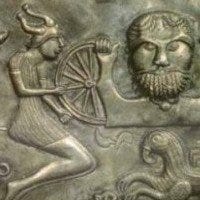Belenos’ name is derived from the reconstructed proto-Celtic elements *belo- (bright/shining), the deicific particle -n- and the masculine ending -os. Thus, Belenos is ‘The Shining God’.
The Celtic god Belinos is the god of the sun, light, and moon in Celtic mythology. He is commonly associated with dawn and is believed to bring warmth and healing to his followers. Belinos is also sometimes referred to as Belinus, Belenus, Belenos, and Belinu, among other variations.
Belinos, the son of the goddess Brigid and the god Dagda, is a figure of striking beauty and grace. He is often depicted as a handsome young man with long, flowing hair and a white robe, a sight that inspires admiration and respect. His magical bronze spear, capable of emitting rays of light and healing, adds to his allure.
The god Belinos is often described as the god of healing, warmth, and fertility. He is thought to bring good luck and prosperity to those who follow him. He is also associated with fire and is sometimes depicted as a fire-breathing dragon in folklore.
Belinos, venerated in many cultures, hold a special place in Celtic cultures as a protector. His symbol is a source of comfort and security in various rituals and ceremonies. Believed to be a patron of agriculture and commerce and a defender of good luck and fortune, he instilled a sense of safety and prosperity in his followers.
Some scholars have speculated that the Irish Bel is linked to the god Belenus. On May 1st, for the Celtic festivals of Beltaine ('Bel's Fires'), fires were lit in honour of the deity.
On occasion, cattle were driven between two fires to repeal diseases, which has been compared to the traditional German custom of burning henbane collected on Midsummer to protect the cattle against diseases and witchcraft.
In ancient Gaul and Britain, Apollo was commonly associated with the sun and healing attributes. He may have been equated with fifteen or more different names and epithets (including Belenus, Vindonnus, Grannos, Borvo, Maponus, Moritasgus).
It is unlikely, as some have suggested, that the Welsh deity Beli Mawr is etymologically related to Belenos, as though the migration of Brython (Insular Celtic Leanguage) to old and middle Welsh is far more likely to yield the name Belen or Belyn.
Indeed, this is the name we see in the Cymric form (Cynfelen) of the Catuvellauni leader during the Claudian invasion of Britain, Cunobelinos (the hound of Belinos).
The tribe name Catuvellauni itself means ‘The Host of Belinos’, and their most well-known leader, Cassivellaunos’ name, means ‘The Devotee of Belenos’.
There is also the figure of ‘Belen o Leyn’, who figures in triad 62 of the Trioedd Ynys Prydain and is preserved today in the place named Tyddyn Belyn near Tudweilog on the Llŷn Peninsula ELlSG. Beli Mawr is more likely derived from the name of the Gaulish deity Bolgios.
The god was venerated as Apollo Belenus at the curative shrine of Sainte-Sabine (Burgundy), where he was invoked by pilgrims seeking cures for their sickness. Suppose Belenus is interpreted as meaning 'shining, brilliant’. In that case, it can be compared to the Celtic epithet Vindonnus (from *windo- 'white'), attached to Apollo as a deity who restored light and vision to people with eye disease at Essarois (Burgundy).
His symbols were the horse (as shown, for example, by the clay horse figurine offerings at Belenos’ Sainte-Sabine shrine in Burgundy and also the Wheel (as illustrated on the famous Gundestrup Cauldron).
In Gaulish mythology, Belenus’ consort was the goddess Belisama.
Belinos, one of the most widely worshiped gods in the Celtic pantheon, holds a special place in the hearts of many. His influence is felt far and wide, bringing light, hope, and healing to his followers. His symbols, often used to represent progress and the pursuit of happiness, serve as a unifying force, connecting believers across cultures and fostering a sense of community and belonging.
Alan /|\
You may also like to subscribe to The School of Mystery and Magick Newsletter (it’s FREE)





